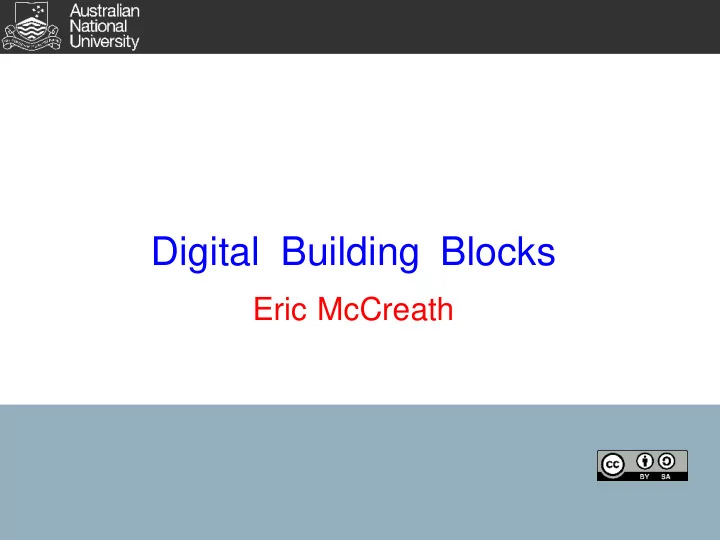

Digital Building Blocks Eric McCreath
A Layered Approach A computer system can be divided up into layers. Each layer is build upon the resources the layer below provides. This is a common design approach for complex systems, as it simplifies and partitions the overall design. 2
Digital Logic Digital logic is concerned with the design of components such as: memory, adders, instruction decoders,.... Hence, it is foundational for computer hardware. The electronics provide the basic gates. These gates are combined together to form the components. The logic is simple and based on Boolean logic. George Boole (1815-64) was first to have framed this logic as an algebra. 3
The Transistor The invention of the transistor in 1947 opened up the way for devices with millions of switching elements. There are a number of different commonly used technologies. These include: Transistor-transistor logic (TTL) family, and Complementary Metal Oxide Semiconductors (CMOS). These different technologies all provide basically the same logic gates. 4
The Transistor Switch The transistor can act as a switch. The switch is a key component in the construction of logic gates. 5
not The 'not' operator evaluates to true when the input is false, otherwise it evaluates to false. 6
and The "and" operator evaluates to true exactly when all its inputs are true. 7
or The 'or' operator evaluates to true when any of its inputs are true. (false otherwise) 8
xor The 'xor' operator evaluates to true when exactly one of its inputs are true. 9
nand The 'nand' operator evaluates to true when any of its inputs are false. 10
nor The 'nor' operator evaluates to true exactly when all of its inputs are false. 11
Design to Truth Table By using the truth tables of the basic gates we can always construct a truth table from a circuit design. 12
Truth Table to Design From any truth table we can also design set of gates that will evaluate the truth table. Note that, this design process goes beyond the scope of this course. 13
Instruction Decoder Instructions are given a particular encoding. The architecture must be able to determine if a particular instruction has been loaded. An instruction decoder can do this. Suppose the instruction "add" has the encoding 0001 then the following circuit could decode it. 14
Binary Adder Binary addition is an important operation required by most architectures. When we add binary numbers by hand we place one number on top of the other. Then we move from right to left adding the digits and remembering to include an carry. This exact approach can be replicated in digital logic. 00110 + 00101 -------- 01011 15
Binary Addition We first create a component that will evaluate one column of the addition. The inputs will be a single bit from each binary number of the column in question. Also the carry in will be provided to this component. 16
Binary Addition We can construct a truth table for this one bit adder. From this truth table we can then design a circuit. 17
Full Adder Inductiveload, public domain, see: http://en.wikipedia.org/wiki/File:Full_Adder.svg 18
8 bit adder We can combine 8 of these 1-bit adders to form a serial 8-bit adder. 19
Exercises Work out the circuit for the below truth table: Work out the truth table for the below circuit: A B Out C 20
Recommend
More recommend